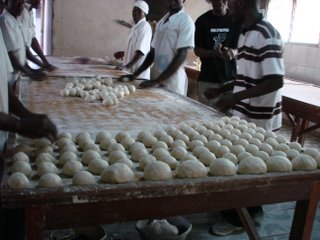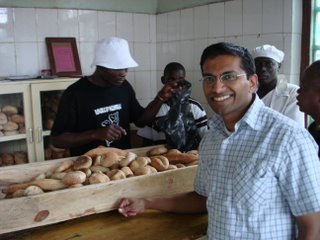Coconut Bread Instead
The week after Rachel did her trip out to the village, we were blessed by a visit from a food scientist from the US. Last fall while I was thinking about the high quality coconut press cake that we produce alongside our coconut oil (and the fact that the local bakery people had basically ignored us after we gave them a big sample to experiment with) I realized we needed to connect with some real food science people to help create higher value uses for the product.
In pursuit of someone, I thought first about our partner churches in the US who have a large number of professional people and diversity of skills that might surely yield one or two good hearted souls who might have an interest to help. So I wrote our staff in Baltimore asking what they thought about the idea. One of them, Sharla, said, “my husband Tim is a food scientist, grew up in Sri Lanka and loves coconut. Could he help?” Who would have guessed such a close connection?

We traveled to Maxixe one morning and saw the mill, with its oil production, and by-products of mature coconut water and press cake. The cake smells and tastes like coconut, is white in color and only needs grinding to make a good nutritional flour with lots of protein, fiber and some residual oil. Everyone who talked about it said how excellent it was and all the things you could do with it, but the local people were only feeding it to chickens.
The next morning, we visited a small bakery and talked to them about possibly using it in their bread making process. The main point of interest for them was that it was a lower cost ingredient. We got their recipe for the standard flour, yeast and water mix and went to our manager Romeu’s kitchen to see what Tim could figure out to do with a combination of the coconut flour and their recipe. When the first batch of bread came out of the oven around 5 PM, one of the 25% coconut flour buns broke apart because it stuck to the bottom of a well-used pan. After our first nibble, we could not stop eating from it. Even the niece, Epiphany, came back for more.
We had promised to come back to the bakery at 7 the next day to show them our results. When we arrived, they were not baking anything. After explaining to them about 3 times and letting them nibble on the samples, they got it and said,
“Where is some flour so we can make our own?”
“You mean now?”
“Yes, right now before you go back to Maputo.”
So, we helped them do the math and made a 1/5th batch in the commercial mixer. We had to pinch ourselves (and take photos) while they were cutting and rolling the balls for individual buns. It really exceeded our expectations.

We left the bakery to let the bread rise and get some breakfast, (eating some of our own creations from the night before). When we got back, they had a tray full of bread out on the counter they were sharing with their customers. I bought a bag to bring back to evaluate and share it at the office. It was quite a hit as it made for a great story and interested eaters who said they really liked it (almost 24 hours after baking). Usually this style of bread gets stale and crusty as it has no oil or fiber to retain the moisture (or preservatives). It was still good Saturday, and even Monday it was still soft to the touch.

Now for the ultimate test—seeing if those who sampled it in Maxixe come back to ask for more and if we can sell it to the bakery on a regular basis.
0 Comments:
Post a Comment
<< Home